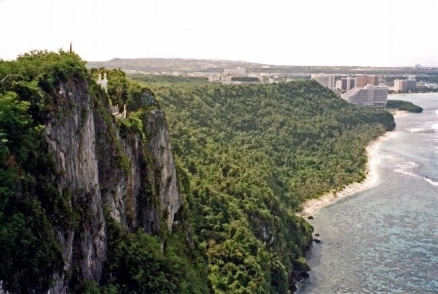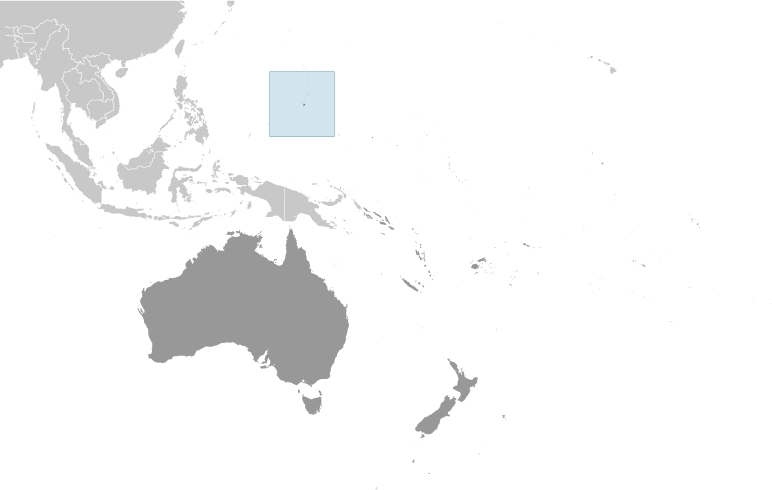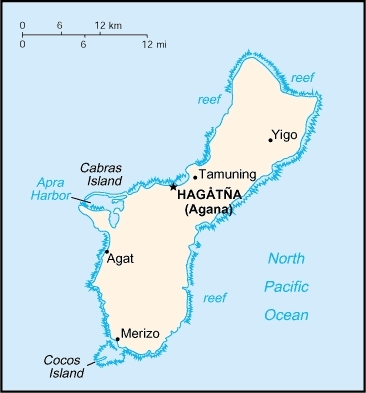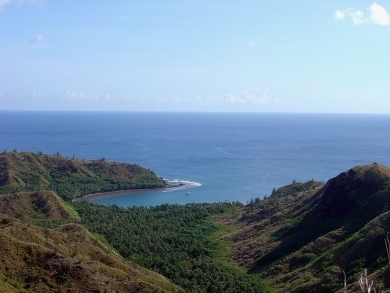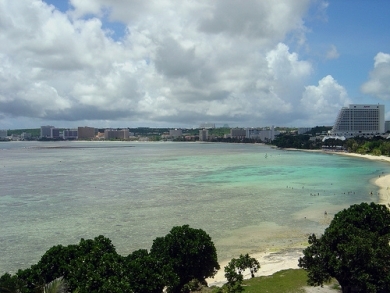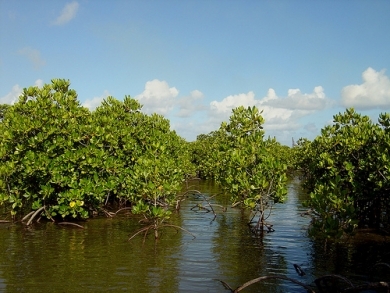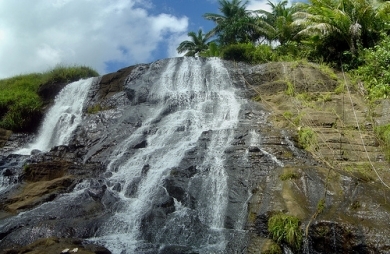Guam
| Topics: |
Guam is an island of under 200,000 people in the North Pacific Ocean, about three-quarters of the way from Hawaii to the Philippines.
Guam was ceded to the United States by Spain in 1898. It is now an organized, unincorporated territory of the US with policy relations between Guam and the US under the jurisdiction of the Office of Insular Affairs, US Department of the Interior.
Captured by the Japanese in 1941, it was retaken by the US three years later. The military installation on the island is one of the most strategically important US bases in the Pacific.
Guam is part of the volcanic island arc of the Mariana Islands which extend about 900 kilometers (km) north-south along the edge of the Mariana Trench in western Micronesia. Guam is the largest and southernmost island in the Mariana Islands archipelago.
The islands can be divided into two distinct groups: the northern, geologically young islands still have some active volcanism; the older southern islands, including Guam, are composed of elevated coral limestone and older weathered volcanic sequences.
Its major environmental issues include the extirpation of the native bird population by the rapid proliferation of the brown tree snake, an exotic, invasive species.
Guam is susceptiblle to frequent squalls during rainy season; relatively rare but potentially destructive typhoons (June - December).
Guam strategic location in western North Pacific Ocean.
Contents
Geography
Location: Oceania, island in the North Pacific Ocean, about three-quarters of the way from Hawaii to the Philippines
Geographic Coordinates: 13 28 N, 144 47 E
Area: 544 sq km
Coastline: 125.5 km
Maritime Claims:
territorial sea: 12 nm
exclusive economic zone: 200 nm
Natural Hazards: frequent squalls during rainy season; relatively rare but potentially destructive typhoons (June - December)
Terrain: volcanic origin, surrounded by coral reefs; relatively flat coralline limestone plateau (source of most fresh water), with steep coastal cliffs and narrow coastal plains in north, low hills in center, mountains in south. The highest point is Mount Lamlam (406 m).
Climate: tropical marine; generally warm and humid, moderated by northeast trade winds; dry season (January to June), rainy season (July to December); little seasonal temperature variation
Ecology and Biodiversity
Ecologically, Guam is part of the Marianas tropical dry forests ecoregion which includes all the Mariana Islands
There has been no volcanic activity since the Miocene, and some of the land on Guam may have been exposed for the past 25 to 30 million years. The volcanic portions of Guam are characterized by many streams and complex drainage patterns. The soils are either highly weathered lateritic clays (oxisols or ultisols) or very young inceptisols.
|
Cetti Bay, on the southern coast of Guam. Source: David Burdick/NOAA |
|
Tumon Bay resort area on the Guam coastline. Source:David Burdick/NOAA |
|
Mangroves growing in the coral rocks of the Guam coastline. Source: David Burdick/NOAA |
|
Inajaran Falls in the interior of Guam. Source: David Burdick/NOAA |
Most of Guam, the largest and southernmost island of the Mariana chain, is covered by secondary growth forest. However, scattered patches of possibly original forest still exist on the northern plateau and in less accessible areas. .
A number endemic plants occur in the Marianas, including the critically endangered Serianthes nelsonii (endemic to Guam and Rota), the endangered Succinea piratarum and Succinea quadrasi, and the vulnerable Aglaia mariannensis, Heritiera longipetiolata (only in crevices of rough limestone, often on cliffs, in Saipan, Tinian, Rota, and Guam). Only 4 individual H. longipetiolata trees remained on Guam in the mid-1980s.
In 1993, a National Wildlife Refuge was established on Guam to protect the remaining forest and the habitat of the Mariana crow (Corvus kubaryi) whose status is considered critical. Four of the northern islands—Farallon de Pájaros, Maug, Asuncion, and Guguan—are also wildlife sanctuaries.
Types and Severity of Threats
A major threat to birds is the potential spread of the introduced brown tree snake (Boiga irregularis), an Australasian native, from Guam to the other Marianas islands. Two bird species extinctions have already occurred on Guam in the 1980s, and the endemic Guam rail (Gallirallus owstoni) is extinct in the wild. The snake numbers on Guam have declined with the bird population, but the snakes are now feeding on an introduced skink, which allows them to maintain their population. Also, the introduction of the black drongo (Dicrurus macrocercus), a passerine bird native to Africa, Asia, and Australia, has been implicated in the rapid decline of the Rota bridled white-eye (Zosterops rotensis). Cattle, pigs, and goats represent a threat to native vegetation, and there is little available information about the introduced Philippine deer in the Marianas.
People and Society
Population: 185,674 (July 2012 est.)
Ethnic Groups: Chamorro 37.1%, Filipino 26.3%, other Pacific islander 11.3%, white 6.9%, other Asian 6.3%, other ethnic origin or race 2.3%, mixed 9.8% (2000 census)
Age Structure:
0-14 years: 27% (male 25,577/female 23,836)
15-64 years: 65.5% (male 61,237/female 58,891)
65 years and over: 7.5% (male 6,287/female 7,458) (2011 est.)
Population Growth Rate: 1.276% (2012 est.)
Birthrate: 17.55 births/1,000 population (2012 est.)
Death Rate: 4.78 deaths/1,000 population (July 2012 est.)
Net Migration Rate: 0 migrant(s)/1,000 population (2012 est.)
Life Expectancy at Birth: 78.5 years
male: 75.46 years
female: 81.73 years (2012 est.)
Total Fertility Rate: 2.45 children born/woman (2012 est.)
Languages: English 38.3%, Chamorro 22.2%, Philippine languages 22.2%, other Pacific island languages 6.8%, Asian languages 7%, other languages 3.5% (2000 census)
Literacy (age 15 and over can read and write): 99% (1990 est.)
Urbanization: 93% of total population (2010) growing at an annual rate of change of 1.2% (2010-15 est.)
Government
Dependency status: organized, unincorporated territory of the US with policy relations between Guam and the US under the jurisdiction of the Office of Insular Affairs, US Department of the Interior
Capital: Hagatna 153,000 (2009)
Legal System: common law modeled on US system; US federal laws apply.
Water
Total Renewable Water Resources:
Freshwater Withdrawal: (domestic, industrial, agricultural)
Per Capita Freshwater Withdrawal:
Agriculture
Agricultural products: fruits, copra, vegetables; eggs, pork, poultry, beef
Irrigated Land: 2 sq km (2008)
Resources
Natural Resources: aquatic wildlife (supporting tourism), fishing (largely undeveloped)
Land Use:
arable land: 3.64%
permanent crops: 18.18%
other: 78.18% (2005)
Economy
The economy depends largely on US military spending and tourism.
Total US grants, wage payments, and procurement outlays amounted to $1.3 billion in 2004.
Over the past 30 years, the tourist industry has grown to become the largest income source following national defense. The Guam economy continues to experience expansion in both its tourism and military sectors.
GDP: (Purchasing Power Parity): $2.5 billion (2005 est.)
GDP: (Official Exchange Rate): $2.773 billion (2001)
GDP- per capita (PPP): $15,000 (2005 est.)
Industries: US military, tourism, construction, transshipment services, concrete products, printing and publishing, food processing, textiles
Currency: US dollar
Further Reading
- Allison, A. 1996. Zoogeography of amphibians and reptiles of New Guinea and the Pacific region. Pages 407-436 in Keast, A. and S.E. Miller, editors. The origin and evolution of Pacific island biotas, New Guinea to Eastern Polynesia: Patterns and processes. SPB Academic Publishing, Amsterdam. ISBN: 905103136X
- Craig, R.J. 1992. Ecological characteristics of a native limestone forest on Saipan, Mariana Islands. Micronesia, 25:85-97.
- Dahl, A.L. 1986. Review of the protected areas system in Oceania. International Union for Conservation of Nature and Natural Resources, Commission on National Parks and Protected Areas, in collaboration with the United Nations Environment Programme. ISBN: 2880325099
- Falanruw, M.V.C. 1989. Vegetation of Asuncion: A Volcanic Northern Mariana Island. Resource Bulletin PSW-28. USDA, Southwest Forest and Range Experiment Station. Berkeley, CA.
- Flannery, T.F. 1995. Mammals of the southwest Pacific islands. Reed, Chatswood. ISBN: 0801431506
- Fosberg, F.R. 1960. The vegetation of Micronesia. Part 1. General descriptions, the vegetation of the Mariana Islands, and a detailed consideration of the vegetation of Guam. Bulletin of the American Museum of Natural History, 119:1-75.
- Hilton-Taylor, C. (compiler) 2000. 2000 IUCN Red List of Threatened Species. IUCN, Gland, Switzerland. ISBN: 2831705657
- IUCN. 1991. Directory of protected areas in Oceania. International Union for Conservation of Nature and Natural Resources. ISBN: 2831700698
- Mueller-Dombois, D. and F.R. Fosberg. Vegetation of the Tropical Pacific Islands. Springer-Verlag New York, Inc. ISBN: 038798285X
- Obha, T. 1994. Flora and vegetation of the northern Mariana Islands, Micronesia. Biological Expedition to the Northern Mariana Islands, Micronesia. A. Asakura and T Furuki, editors. Natural History Research, Special Issue No. 1: 13-69. Natural History Museum and Institute. Chiba, Japan.
- Raulerson, L., and A. Rinehart. 1991. Trees and Shrubs of the Northern Mariana Islands. Coastal Resources Management. Saipan, Northern Mariana Islands. ISBN: 1878453084
- Slikas, B., Jones, I.B.; Derrickson, S.R. Fleischer, R.C. 2000. Phylogenetic relationships of Micronesian white-eyes based on mitochondrial sequence data. Auk April, 2000. 117(2):355-365.
- Stattersfield, A.J., M.J. Crosby, A.J. Long, and D.C. Wege. 1998. Endemic bird areas of the world: priorities for biodiversity conservation. BirdLife Conservation Series No. 7. BirdLife International. Cambridge, UK. ISBN: 0946888337
- Van Balgooy, P.H. Hovenkamp, and P.C. Van Welzen. 1996. Phytogeography of the Pacific – floristic and historical distribution patterns in plants. Pages 191-213 in Keast, A. and S.E. Miller, editors. The origin and evolution of Pacific island biotas, New Guinea to Eastern Polynesia: Patterns and processes. SPB Academic Publishing, Amsterdam. ISBN: 905103136X
- Wemmer, C., ed. 1998. Deer Status Survey and Conservation Action Plan. IUCN, Gland, Switzerland. ISBN: 2831704545
